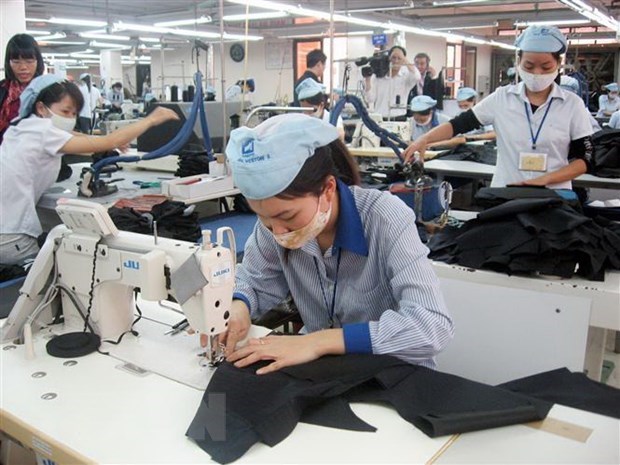 |
|
|
“We believe that the COVID-19 outbreak will heavily impact growth in the first half of the year, mainly due to disrupted supply chains in the region which would weigh heavily on manufacturing and weak tourist arrivals as well as general domestic fears of infection which would drag on services activity,” analysts of the global financial information services provider said in a report released on February 25.
"That said, our forecasts currently factor in our assumption of a gradual subsiding of the virus outbreak in the second half of 2020, which underpins our view for a sharp rebound in trade activity as supply chains and tourism activity normalises."
Fitch forecast Vietnam’s large manufacturing sector (accounting for 16 percent of the country’s GDP) to come under pressure from supply chain disruptions as a result of the COVID-19 outbreak in China, which is a key source of raw materials and also a major export market for Vietnam.
China is Vietnam’s largest source of imports, accounting for around 28 percent of total imports, and is its second largest export market after the United States (20 percent), accounting for around 17 percent of total exports.
“We believe that the lack of inputs and demand shock from Vietnam-China border closures and multi-city lockdowns in China will weigh heavily on manufacturing growth in the first half of 2020.”
According to Fitch, while some companies such as Samsung are flying in inputs to circumvent the supply chain disruption from China, it believes that many companies, particularly small to medium-sized firms, are likely to struggle in their search for an alternative source of inputs at short notice.
Fitch forecast services (accounting for 42 percent of the country’s GDP) growth would also come under stress from weaker domestic and foreign demand as work disruptions, which would impact wages, and general paranoia of community cross-infection of the coronavirus would see weaker retail activities, which account for about 11 percent of GDP.
Weak domestic demand is likely to also feed through to the rest of the services sector, especially tourism.
“While tourism only accounts for 9.2 percent of total GDP, a shock in this area would nevertheless still impact the overall growth outlook for 2020,” the analysts noted.
However, Fitch believed that support measures by the Government would help alleviate the negative growth shock.
Fitch expected growth to rebound in the second half of 2020, assuming the virus subsides by then.
“We believe that this would be underpinned by a clearing of backlogged factory orders during the first half of the year upon the normalisation of supply chains, and pent up tourism demand following an easing of global uncertainty around the virus’ outbreak.”
In addition, Fitch expected trade is likely to also benefit from Vietnam’s ratification of the EU-Vietnam Free Trade Agreement (EVFTA), which would eliminate tariffs on more than 90 percent of all of Vietnam’s exports to the bloc.
Working session discusses support to sectors hit by COVID-19
Minister of Industry and Trade Tran Tuan Anh chaired a meeting in Hanoi on February 26 to discuss support to sectors hit by COVID-19 outbreak.
According to the Ministry of Industry and Trade’s Industry Department, Vietnam’s manufacturing and processing sector mostly relies on materials and spare parts imported from China, the Republic of Korea and Japan.
The hardest-hit sectors include electricity-electronics; apparel, leather, footwear and handbag; and automobile manufacturing and assembling.
By the end of this year’s first quarter, it is forecast that automakers and assemblers will run short of spare parts for manufacturing.
Participants suggested the government direct ministries, agencies and localities to work with Chinese counterparts to consider border restriction measures, thus ensuring sufficient input for domestic production.
They proposed offering incentives to facilitate the switch of manufacturing, especially spare parts, to Vietnam from China.
Deputy Minister Cao Quoc Hung highlighted the need to work with each association and sector to learn about impact of the epidemic so as to offer support to businesses in the most effective manner.
The Ministry of Planning and Investment predicted that the added value of the industry sector will hike only 5.18 percent if the epidemic ends in the first quarter, compared to 9 percent and 10.45 percent in the same period of 2019 and 2018, respectively.
If the epidemic is put under control in the second quarter, the figure will rise by 5.33 percent, lower than the 9.24 percent year-on-year and the 8.34 percent in the same period of 2018.
Lang Son restores cross-border trade activities by locals
The northern border province of Lang Son on February 26 agreed with China’s proposal to resume cross-border trade activities by local residents.
Starting from February 27, border dwellers could go through Vietnam’s Tan Thanh and China’s Pu Zhai auxiliary border gates, each with 8,000 yuan worth of commodities each day.
Vice Chairman of the Lang Son People’s Committee Nguyen Cong Truong said that drivers carrying goods through the border are only allowed to arrive at certain delivery points and quarantine areas at the border gates to prevent the risk of potential exposure to the acute respiratory disease caused by SARS-CoV-2 (COVID-19).
Sterilisation must be carried out thoroughly at the border gates while drivers and traders are asked wear protective suits and go into quarantine if they develop symptoms of the disease./.VNA/VNN

Vietnamese carriers suffer from coronavirus outbreak
Vietnamese carriers saw significant drops in the number of passengers in February due to the outbreak of the novel coronavirus (COVID-19).

Foreign investors still eye Vietnam amid Covid-19 outbreak
Foreign investors still pay great attention to Vietnam albeit the complicated developments of the acute respiratory disease caused by Covid-19 which started to hit the world earlier this year.
 Fitch Solutions has revised down its 2020 real GDP growth forecast for Vietnam to 6.3 percent, from 6.8 percent previously, in light of the worsening global COVID-19 outbreak.
Fitch Solutions has revised down its 2020 real GDP growth forecast for Vietnam to 6.3 percent, from 6.8 percent previously, in light of the worsening global COVID-19 outbreak.